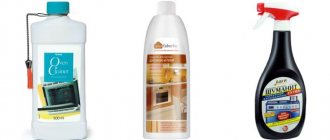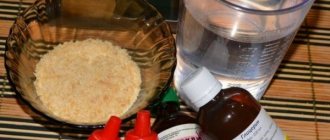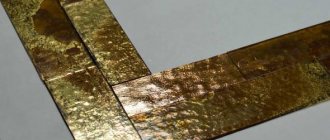The deliciously crispy, golden crust of the meat and the dizzying aroma of vegetables baked in the oven will leave few people indifferent. It is rare that cooking in the oven is complete without oil splashing and soot settling on the inner walls of the kitchen appliances.
Washing a device is a tedious procedure, however, thanks to the use of some available tools, it is quite possible to turn cleaning into a process that requires minimal effort and time.
Basic rules
It is convenient if the electric stove is equipped with a special self-cleaning system, but what should families do that have not acquired an expensive new product?
Expert opinion
We recommend!
If your appliances are covered with grease so that you can smell something burnt when you use them, and an unpleasant dark coating has formed on the glass door, don’t worry – you don’t have to give up your favorite dishes or buy new appliances. You can easily return surfaces to their original cleanliness.
In some cases, it is enough to simply place a baking tray with water in the oven. The stove heats up, the water begins to evaporate, and the fat slowly melts.
But water alone is not enough for the quality of cleaning to be high. Theoretically, you can add store-bought products to the water, but doctors have an extremely negative attitude towards them.
To preserve your kitchen appliances and your own health, follow a few simple rules:
- Clean your oven frequently, ideally after each cooking episode. Once a week you need to wash the oven not just with water, but with home remedies. With this scheme of action, global general cleaning will not be necessary.
- To make the carbon deposits easier to clean, the stove needs to be slightly warmed up for 15 minutes. Temperature – comfortable for the skin (not higher than 50°C).
- Before washing, remove the baking sheets and removable elements. Don't forget to remove the front glass and door (if they have such a function). It is more convenient to wash each part separately.
- It is strictly prohibited to use iron scrapers or hard abrasive sponges. These elements can scratch paint and glass. A soft cloth or sponge is suitable for cleaning delicate surfaces.
- It is prohibited to apply any chemical substance to heating electric elements or fan blades.
- After cleaning, the door should be opened for several hours to allow the equipment to dry completely. This will help get rid of odors.
- If there is still a smell inside, it is recommended to purchase activated carbon at the pharmacy. 15 tablets are diluted in a glass of water and left overnight. Coal absorbs foreign odors.
Recommended for you:
How to clean rust with soda
Expert opinion
Advice!
NaHCO3 perfectly removes fresh dirt and dark deposits from glass elements. Vinegar helps get rid of odors. Lemon acid removes recent stains.
You can use baking powder, which removes fatty deposits. Salt is effective immediately after cooking. Some housewives use ammonia to remove burnt marks in stoves.
Method 4. Effective
This method will make it much easier for you to get rid of complex contaminants due to ammonia vapor.
What you need:
- 5 bottles of ammonia (200 ml);
- Soda (if necessary);
- Small bowl for ammonia;
- Large bowl for water;
- Water (about 1 l);
- Latex gloves;
- Sponge and rag;
- ...Fresh air from an open window.
Instructions:
- Remove pans from oven: Remove and set pans aside, but leave racks on.
- Preheat the oven to 180 degrees.
- Pour the water and ammonia into their respective bowls: While the oven is heating, pour all 5 bottles of ammonia into a small bowl and the water into a large bowl. Don't forget to open the windows.
- Turn off the oven and place both bowls in it: in the preheated oven, place a bowl of water on the bottom of the oven, and place a bowl of ammonia a little higher (on the shelf).
- Leave the oven to cool: this process will take approximately 30-40 minutes. But, if the stains are very old, then it is better to leave the bowl of ammonia overnight.
- Clean the oven and grate: when the walls of the chamber have cooled, use a damp cloth, sponge and baking soda to remove grease and carbon from all surfaces and the grate.
- Wipe the oven clean: remove any remaining residue from the ammonia solution and dirt.
- Place the pans and rack back in place and wipe down the outside of the oven door.
See also the material: How to clean an automatic washing machine from dirt and scale in 5 steps.
How to clean the oven: vinegar and soda
You can clean the cabinet of grease and carbon deposits using sodium bicarbonate and vinegar. The chemical formula obtained by the interaction of ingredients easily copes with old stains.
The stages of work are as follows:
- The surfaces inside are wiped with foam rubber soaked in vinegar. It is better for the housewife to wear gloves to protect her skin.
- After this, baking soda is poured onto the same foam rubber, which should be applied to the problem area. A thin layer of NaHCO3 is also applied to the open door.
- After three hours, the powder is removed with a rag. Surfaces are washed and dried.
The recipe is as convenient as possible for cleaning an electric stove; sodium bicarbonate is an exceptionally soft abrasive and does not harm surfaces.
Recommendations
To ensure that your oven is maintained without any unpleasant consequences, it is recommended to use the following expert advice:
- Traditional cleaning methods are often no less effective than store-bought products.
- It is advisable to carry out work on cleaning the oven using rubber gloves.
- Before using a specific preparation for the oven, be sure to study the instructions for it.
- When cleaning the oven, do not forget about the door. Its interior is washed with the same composition as the entire oven.
- Cleaning the oven should only begin after removing the dishes, racks and baking trays.
Soda, vinegar, salt
A paste using salt quickly removes carbon deposits.
- Pour 2 kg of rock salt, 2 tbsp into a liter of water. l. vinegar. The mixture is stirred until the ingredients are completely dissolved.
- The container is placed down in the oven (in a heated oven).
- The product is heated for half an hour, after which the resulting wall condensation is washed off with a damp sponge.
Recommended for you:
How is caustic soda used in everyday life?
Steam treatment
You can clean the oven from carbon deposits using steam treatment. It is best, of course, to use a special steam generator, which effectively softens fat deposits, after which they can be easily washed off yourself. If you don't have a steam generator at hand, try an alternative method. Fill a baking tray or oven-safe container with water and add some detergent.
The heating temperature should be no more than 150 degrees. Heating time is about half an hour. During this procedure, layers of fat and burning are exposed to steam and become softer. Remove them with a regular sponge with a hard surface. This method can also be used in combination with others to easily and quickly clean the oven of old grease without having to think about which method is the best.
Soda
To work, you will need a silicone spatula, a bottle with a dispenser, and water. How to clean the oven with soda, vinegar, salt, citric acid?
Cleaning consists of sequential steps. First you need to remove the baking sheets and separable elements from the oven. Then you need to prepare a soda emulsion.
Take half the volume of baking soda required for a particular case and a little water to form a kind of slurry.
The resulting paste is applied in a thick layer to the dirty internal surfaces of the cabinet. It is strictly prohibited to apply the mixture to heating elements.
After this, the oven is left for the whole day to allow the reaction between NaHCO3 and the metal to occur.
It is necessary to wash the baking sheets and the remaining elements removed from the oven. After time has passed, sodium bicarbonate is removed from the oven using foam rubber or a rag.
In difficult places you will have to use a silicone spatula. For final cleaning, you can use vinegar, which is diluted with water.
It is more convenient to apply the solution using a spray bottle to the cabinet walls. The vinegar solution easily removes powder residues.
Dishwashing liquid
You can use dishwashing liquid instead of citric acid. Add about 50 ml of product to a bowl of water and heat the solution until it boils. Then go over the walls with the hard side of a sponge or a plastic spatula.
Visually, the process of cleaning the oven with citric acid and dishwashing detergent looks the same.
Soda and citric acid
Lemon acid will help get rid of not only plaque, but also foreign odors. Use a couple of bags of artificial “lemon” or lemon juice, add a little water and NaHCO3.
Recommended for you:
How to use soda against mosquito bites: outdoors, in the countryside, at home
This paste should be applied with a soft cloth. The remaining paste in a glass container at a temperature of 50°C is placed inside the oven for 30 minutes.
After cooling, the stove is washed with plain water. It is not advisable to apply the paste to glass surfaces so that abrasive particles do not leave scratches.
Store-bought oven cleaners
The easiest way to quickly clean carbon deposits is to use special products. They are suitable for cleaning Bosch, Electrolux ovens and household appliances of other brands. Such products are specifically designed to remove old grease from the surface of built-in ovens. They can be used at home.
Such products contain acids or alkalis that remove stubborn fat without any effort. They are usually available in the form of a gel or spray, which can be easily applied to the inside of the oven. After applying them, wait 5 to 30 minutes. Then simply wipe the surface with a sponge. During this time, the carbon deposits will dissolve.
Pay attention to the following products that will help you easily wash away old fat:
- "Shumanite";
- Amway Oven Cleaner;
- "Shine";
- Faberlic;
- Sanita Anti-grease.
All these products are caustic, you need to work with them strictly according to the instructions, you need to take into account the cleaning time and method of application.
Be sure to use rubber gloves.
For example, let's look at how to clean an oven using Schumanite.
This is a caustic agent that can cope with any contaminants. It is often used by professional chefs. If you clean the oven with it at home, you need to proceed as follows:
- put on gloves, open the windows;
- apply the product to the walls, door;
- leave the oven closed for 5 minutes;
- remove with a soft sponge;
- rinse it with clean water.
If you don’t have such a product at home, you can take those chemicals that are often used. Sometimes housewives are interested in whether it is possible to clean the oven with Domestos. Use this product in the form of a cream and then thoroughly remove its remnants from the inside of the thermal chamber.
Reviews from people
Maria, 45 years old
I had no idea that sodium bicarbonate is another name for regular baking soda. I always use kitchen products to clean the oven. It washes off perfectly, why bother with chemicals from the store?
Nadezhda, 26 years old
I recently got married, my husband loves all sorts of baked things. I learned to cook, but the oven fell into disrepair. I wanted to buy a new stove; I didn’t believe it could be cleaned. Thank you very much for the simple recipes.
Vasily, 40 years old
As a chef in my own small cafe, I confirm that it is much more economical and convenient to use homemade recipes. I teach my employees recipes for detergents; for many it turned out to be a revelation. I don’t understand why the industry doesn’t produce using home remedies?
Nina, 32 years old
My child has allergies, so I don’t use industrial chemicals. I suffered with shampoos, detergents, and soaps. My husband, a chemist by profession, told me to wash the kitchen with NaHCO3. The doctor approved it, it turned out that this is a hypoallergenic product. Many problems have gone away, allergic manifestations have decreased.
Safety regulations
To ensure that cleaning equipment is not only effective, but also as safe as possible, it is important to follow the following rules:
- Before you start cleaning, after warming up the oven to soften the fat, you must turn it off.
- It is necessary to remove rings, bracelets, watches, and other accessories before cleaning.
- Even if you don’t consider your skin to be sensitive, you should use household gloves when washing the oven.
- If the cleaning composition does get on the skin, it must be washed off immediately with warm water.
- While cleaning, restrict access to the kitchen for children and pets.
Note! The room must be well ventilated during cleaning of equipment and after it is completed (until the smell of cleaning products is removed).
Any home remedy is safer and more economical than those offered by manufacturers. However, it must be used wisely, following safety rules.
Question answer
How to clean oven glass?
To clean the oven glass, you can use the methods described above, or this recipe: prepare a paste of baking soda and water (3:1) and spread it (using rubber gloved hands) over the glass. Then let the solution work for 15 minutes. Finally, use a stiff sponge and rag to wipe the surface clean in a circular motion.
For stubborn stains, the oven heating method is suitable. Warm it up to 40-50 degrees Celsius (no more). Once the desired temperature is reached, turn off the oven, open the door and leave for a minute to cool slightly. As soon as the door becomes warm and stops burning your fingers, start cleaning the glass. To do this, you can use a safe cleaner (for ovens and microwaves). Lightly rub the glass with it so that it does not drip down, then close the door for 5 minutes. Finally, clean the door using a sponge and rag in a circular motion.
Preparatory stage
To clean a technical device, you must first prepare:
- Wait until it cools down completely.
- Shut off the gas supply so that the washing process is completely safe.
- Remove the top grill and removable burners; they will be washed separately.
- It is better to wear protective gloves to protect your skin from the negative effects of chemical solutions.
- Prepare all the necessary tools that will be used in the work.
Cleaning Sequence
Let's try to figure out how to clean a gas stove at home without extra costs and without harm. You need to choose the best product for yourself, prepare it yourself, and clean the gas stove. By testing, determine an effective method. There is no need to prepare a new composition every time. There is nothing more accessible and simpler than folk remedies for care. They are stored for several months in a cool, dark place.
The recipes listed may be modified depending on the availability of available materials at home. To effectively clean a gas stove, you need to follow the algorithm of actions. This is the only way to achieve the desired result.
Removing carbon deposits
There are several effective ways that can solve the problem of carbon deposits:
Activated carbon
Several tablets should be crushed to a powder state. Next, you need to pour the resulting powder onto the dirty areas and soak thoroughly with warm water, let it sit for a while. Then wash everything with a wet cloth.
Anise-ammonia drops
They need to be dripped onto dirty places and sprinkled with a little baking soda on top. Leave everything for a short period of time and rinse the stove well with a wet cloth, and finally wipe the surface until dry.











